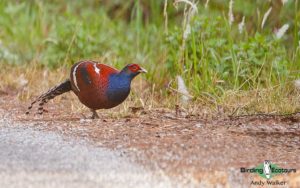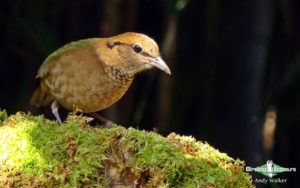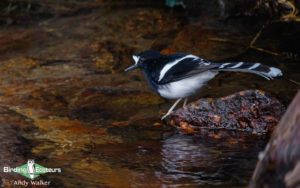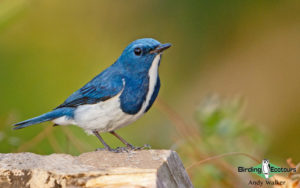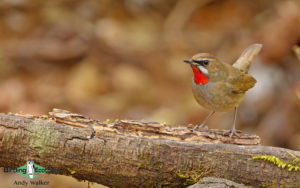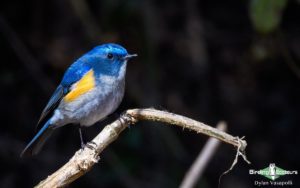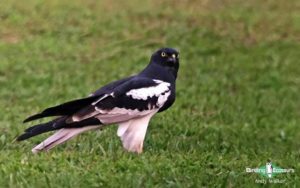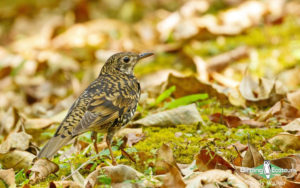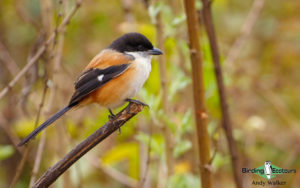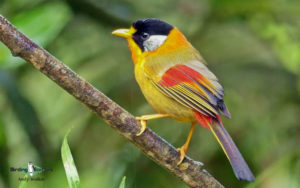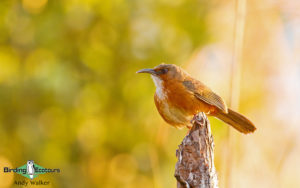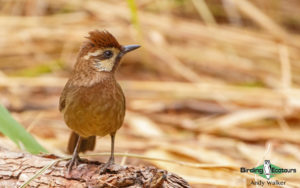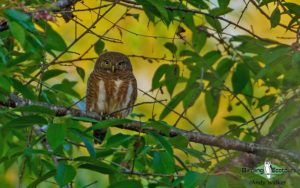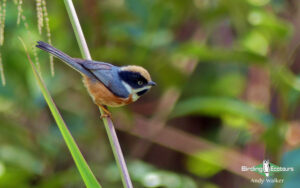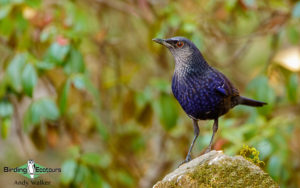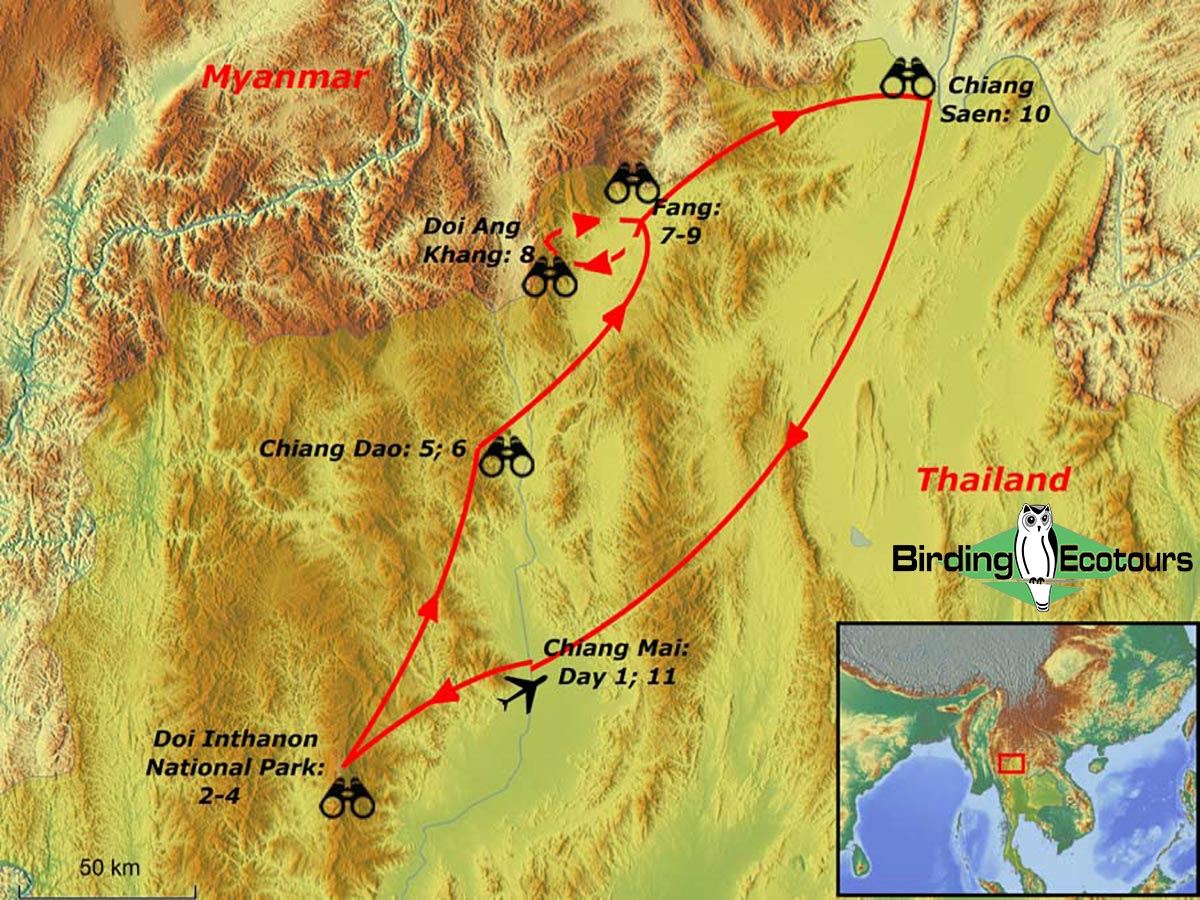Birding Tour Thailand: Northern Thailand – Spectacular Resident and Migrant Birds
Go to: Thailand Birding Tours | Birding Tours in Asia | All our birding tours
Northern Thailand Birding Tour: Spectacular Resident and Migrant Birds
February 2026
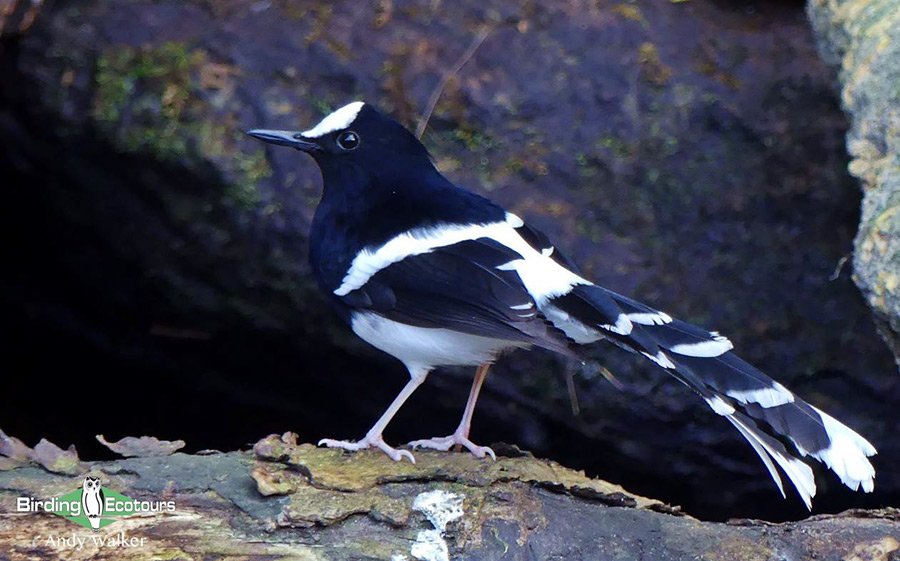
This short tour forms a circuit around northern Thailand, starting and ending in the northern capital city of Chiang Mai. We will commence our experience of northern Thailand birding with a visit to Doi Inthanon, the country’s highest mountain. The unique set of habitats here offers us some excellent birds as well as letting us come to grips with some of the more common northern species. Special birds here may include Rufous-throated Partridge, Mountain Bamboo Partridge, Black-tailed Crake, Spectacled Barwing, Himalayan Bluetail, Himalayan Shortwing, Dark-sided Thrush, White-crowned, Slaty-backed, and Black-backed Forktails, Long-tailed Broadbill, and Red-headed Trogon. The dry, lowland forest at the foot of the mountain can be full of woodpeckers, and the stunning Black-headed Woodpecker is one of the best-looking. Other targets here will include White-rumped Falcon, Red-billed Blue Magpie, and Blossom-headed Parakeet.
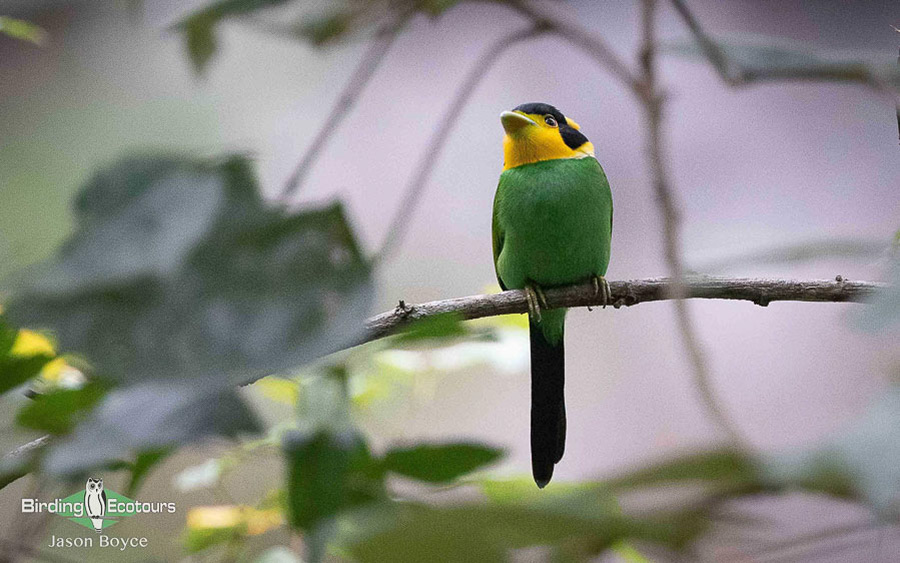
After our exploration of areas to the southwest of Chiang Mai we will head back north and spend the next few days birding at several mountain sites close to, and sometimes along, the Thai-Myanmar border (e.g. Doi Chiang Dao, Doi Ang Khang, and Doi Lang). These mountains support huge numbers of overwintering migrants from China, such as numerous warblers, flycatchers, chats, thrushes, finches, and buntings, and also some very highly sought resident species like Mrs. Hume’s Pheasant, Hodgson’s Frogmouth, Rusty-naped Pitta, Himalayan Cutia, Scarlet-faced Liocichla, Silver-eared Mesia, Silver-breasted and Long-tailed Broadbills, and the decreasing Giant Nuthatch. Between the mountains here much of the land is farmed for rice, and these rice paddies often also hold exceptional numbers of migrants and a few interesting resident birds, here we will look for Greater Painted-snipe, Siberian Rubythroat, Yellow-breasted Bunting, and Wire-tailed Swallow.
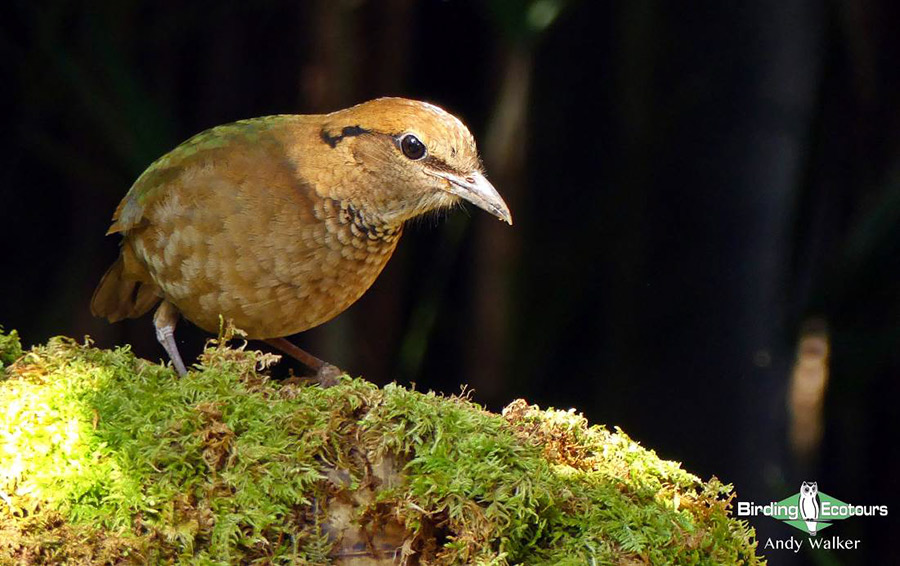
The final stop of this exciting tour will see us visiting the famous Mekong River along the Thai-Myanmar-Laos border, in addition to the nearby Chiang Saen Lake. During our time in this area we hope to find the pretty Small Pratincole and, with luck, the Critically Endangered (BirdLife International) Baer’s Pochard that sometimes overwinters on the vast waterbody of Chiang Saen Lake. Plenty of other overwintering wildfowl species are possible too, and there is occasionally something unexpected floating about on the lake, such as Baikal Teal, Mandarin Duck, or Falcated Duck! The evening here is pretty spectacular too, and we end the tour with a visit to a harrier roost where hundreds of Pied and Eastern Marsh Harriers come into the roost site, giving fantastic views as they drop in overhead as the sun disappears.
This tour visits some stunning scenery and incredibly rich forests, and we will sample some of northern Thailand’s famed, delicious food during our journey. Furthermore, some of the temples that we will drive past while birding are absolutely spectacular and worth spending time to appreciate in their own right. Several sites visited also offer very good photographic opportunities for those with an interest in photographing Asian birds.
This tour can easily be combined with our Central Thailand Birding Tour: Shorebird Spectacle and Jungle Birding, which runs immediately before this one starts, think of mega birds like Spoon-billed Sandpiper, Nordmann’s Greenshank, White-faced Plover, Chinese Egret, Blue Pitta, Coral-billed Ground Cuckoo, Silver Pheasant, and Siamese Fireback etc. for that tour! Our Southern Thailand Birding Tour: Jewels of the South (which features Helmeted Hornbill, White-crowned Hornbill, Scarlet-rumped Trogon, Malayan Banded Pitta, Mangrove Pitta, Green Broadbill, and many more outstanding birds) starts a few days after the conclusion of this northern Thailand tour and thus could also be combined with our other Thailand tours for an exciting and comprehensive Thailand birding adventure.
Detailed Itinerary (11 days/10 nights)
Day 1. Arrival in Chiang Mai
After your afternoon arrival in Chiang Mai you will take the short transfer to our nearby hotel for the night with the rest of the day at leisure. We will have a group evening meal together. Those who are continuing from the central Thailand tour will take their flight from Bangkok to Chiang Mai and meet up with the other tour participants at the evening meal.
Overnight: Chiang Mai
Days 2 – 4. Three full days of birding Doi Inthanon National Park
We will have an early breakfast in our hotel in Chiang Mai before leaving the city and heading straight to Doi Inthanon National Park for what is sure to be an excellent introduction to birdwatching in northern Thailand; there are an awful lot of birds to look for here! Doi means mountain in Thai, and Doi Inthanon is Thailand’s highest mountain (at 8,415 feet/2,565 meters) and supports some unique habitat in the country. As a result it is a must-visit birding spot, as it holds several species that are not found elsewhere in the country. In addition to the amazing birds and forests here, the views are incredibly impressive, and on a clear day you can see for miles, and sometimes you can even be up above the clouds! There are several different roads (including one right to the top, so minimal effort is required to cover the different elevations for birding), trails, and access points at various elevations, which will allow us to thoroughly explore the different types of forests, the unique bog habitat at the summit of the mountain, and the many rivers heading down the mountainside, which are also worth checking.
Around the lower elevations we will seek Blossom-headed Parakeet, Siberian Rubythroat, Pallas’s Grasshopper Warbler, Amur (Stejneger’s) Stonechat, Asian Barred Owlet, Spotted Owlet, Brown Boobook, Large-tailed Nightjar, Red-billed Blue Magpie, Banded Bay Cuckoo, Chestnut-headed Bee-eater, Striated Swallow, Collared Falconet, Eurasian (White-faced) Jay, Black-headed Woodpecker, and many more. As we pass rivers, waterfalls, and damp areas we will stop and look for White-crowned, Black-backed, and Slaty-backed Forktails, Plumbeous Water Redstart, White-capped Redstart, Grey Wagtail, and Blue Whistling Thrush (both resident and migrant subspecies occur here, one with a yellow bill, the other with a black bill, a possible future split?).
Forest birding high up and around the bog is likely to get us some great birds, and as time goes by (usually once the sun gets onto the trees and warms things up in the morning) things start to really happen here. We hope to find Rufous-throated Partridge, Mountain Bamboo Partridge, Ashy Wood Pigeon, Black-tailed Crake, Golden-throated Barbet, Yellow-bellied Fantail, Yellow-cheeked Tit, Silver-eared Laughingthrush, Spectacled Barwing, Dark-backed Sibia, Silver-eared Mesia, Blue-winged Minla, Himalayan Shortwing, Scaly and Dark-sided Thrushes, Buff-barred and Ashy-throated Warblers, Slaty-backed and Snowy-browed Flycatchers, Yellow-bellied Flowerpecker, Mrs. Gould’s, Black-throated, and Green-tailed Sunbirds, and Common Rosefinch.
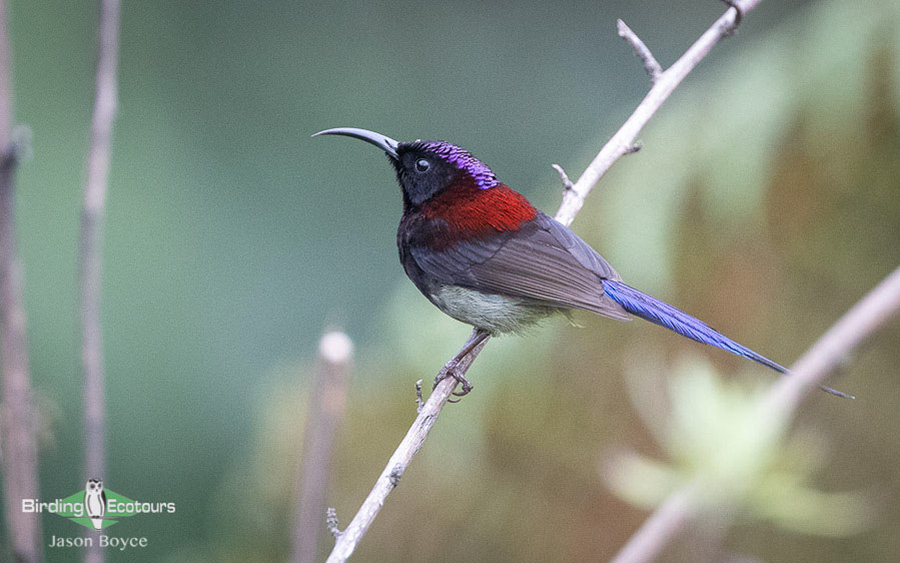
Some of the highlight birds in the middle elevations and foraging in the trees here include Red-headed Trogon, Long-tailed Broadbill, Maroon Oriole, Lesser Racket-tailed Drongo, Stripe-breasted Woodpecker, White-browed (Blyth’s) Shrike-babbler, Clicking Shrike-babbler, Hume’s Treecreeper, Chestnut-vented Nuthatch, Rufous-backed Sibia, Little Pied and White-gorgeted Flycatchers, Large Niltava, Small Niltava, Rufous-bellied Niltava, Rufous-winged Fulvetta, and Yunnan Fulvetta.
While searching on the forest floor here we will try our luck with the secretive Pygmy and Eyebrowed Wren-Babblers, Asian Stubtail, Slaty-bellied Tesia, White-tailed Robin, Lesser Shortwing, and Siberian Blue Robin. The mountain can also turn up some interesting migrant thrushes (e.g. Chestnut, Grey-sided, White’s, and Eyebrowed Thrushes), chats (e.g. Himalayan Bluetail and Blue-fronted Redstart), and warblers (e.g. Pallas’s Leaf Warbler), and we will certainly be looking for those.
Overnight: Doi Inthanon
Day 5. Morning birding Doi Inthanon area, afternoon transfer to Chiang Dao
After the morning birding session in the Doi Inthanon area we will head north, back past Chiang Mai and up to the foot of the spectacularly scenic Doi Chiang Dao, a huge mountain that bursts out of some relatively flat rice paddy farmland. If there is time we will check some rice paddies where in the past we have found Brown-cheeked Rail, Ruddy-breasted Crake, Greater Painted-snipe, Eastern Barn Owl, Pied Harrier, Rufous-winged Buzzard, Grey-headed Lapwing, Pin-tailed Snipe, Chinese Pond Heron, Siberian Rubythroat, Pied Bush Chat, Amur (Stejneger’s) Stonechat, Lanceolated, Pallas’s Grasshopper, and Thick-billed Warblers, Long-tailed Shrike, Black-collared Starling, and Wire-tailed Swallow.
Overnight: Chiang Dao
Day 6. High elevation birding at Doi Chiang Dao
We will spend the early morning near the top of Doi Chiang Dao, the seriously impressive massif that bursts out of the ground, seemingly out of nowhere. There are numerous birds to look for here (and a lot of good ones too!), and we will time our 4×4 drive up the rough mountain road to get near the top as the sun rises. We will hope to find the gorgeous Mrs. Hume’s Pheasant along the way, and maybe even Mountain Bamboo Partridge too. Other possibilities up here might include Slender-billed and Maroon Orioles, Grey-headed Parrotbill, Mountain Imperial Pigeon, Himalayan Swiftlet, Grey Treepie, Japanese Tit, Black Bulbul, Hill Prinia, Blue Rock Thrush, Orange-bellied Leafbird, Spot-winged Grosbeak, and Slaty-backed Forktail, along with numerous warblers and migrant flycatchers, possibly even uncommon or rare migrant buntings.
Depending on the weather on the mountain, we may have lunch up here and spend a good chunk of the afternoon continuing birding here. However, if the weather deteriorates, as is fairly common here (or if it gets too hot, which also happens occasionally), we may drop to some middle and lower elevations, or back to the rice paddies. Luckily there are plenty of birds to find in this area so we have lots of options.
Overnight: Chiang Dao
Day 7. Morning near Chiang Dao, afternoon Thaton rice paddies
The morning will be spent birding the forest and gardens near our accommodation, where we might find beautiful species such as Pin-tailed Green Pigeon, Blue-bearded Bee-eater, Silver-breasted Broadbill, or Violet Cuckoo.
After lunch we will transfer to our base for the next few nights in the small town of Fang. In the afternoon we will visit some nearby rice paddies, where we will look for Small Pratincole, Bluethroat, Siberian Rubythroat, Pied Harrier, Yellow-breasted Bunting, Chestnut-eared Bunting, Long-tailed Shrike, Burmese Shrike, Pied Bush Chat, Siberian Stonechat, Amur (Stejneger’s) Stonechat, Pallas’s Grasshopper Warbler, and other open-country birds.
Overnight: Fang
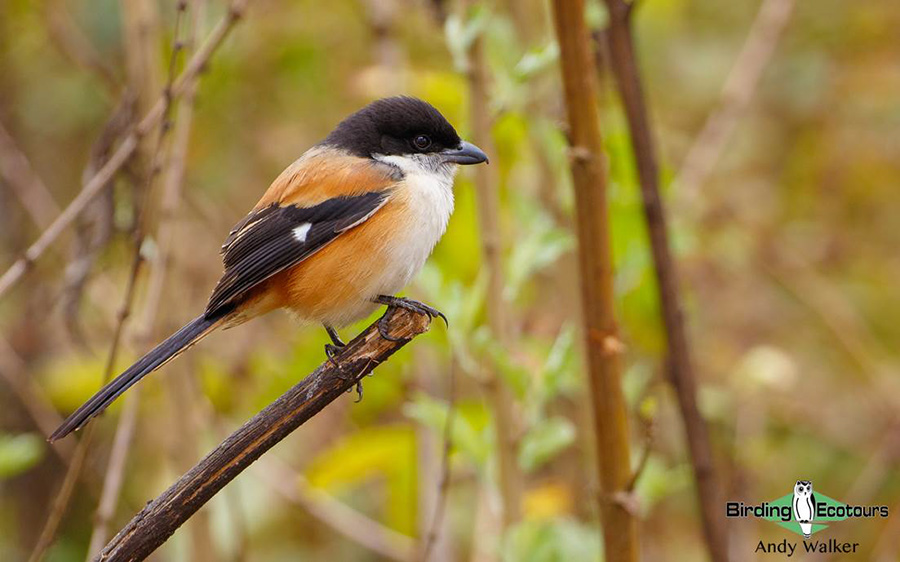
Day 8. Full day birding Doi Ang Khang
The mountain of Doi Ang Khang is a little farther north than Doi Chiang Dao and offers a few different species and other potential Chinese migrants from more southerly areas and is a great vagrant hotspot. We will spend a full day in the forests and beautiful gardens on the mountain, where we will search for numerous Chinese migrants and possible vagrants (warblers, thrushes, flycatchers, and chats) along with some interesting resident species.
The apparently declining Giant Nuthatch is our key target bird here, but there are plenty of other great birds to look for too. Sometimes Rusty-naped Pitta may show up, and if that’s the case we will be sure to try and locate it. Other birds we will try to find during our time here include Mrs. Hume’s Pheasant, White-browed Laughingthrush, Black-eared Shrike-babbler, Striated Bulbul, Spot-breasted Parrotbill, Spectacled Barwing, Scarlet-faced Liocichla, Silver-eared Mesia, Black-breasted Thrush, White-capped Redstart, Black-headed Greenfinch, Siberian Rubythroat, Chestnut-bellied Rock Thrush, Hill Blue Flycatcher, Daurian Redstart, White-tailed Robin, Chestnut-headed Tesia, Streaked Wren-Babbler, Brown-breasted Bulbul, Crested Finchbill, Grey Bush Chat, Common Rosefinch, and Spot-winged Grosbeak. There could be some good photographic opportunities for birds here too.
In the late afternoon we will descend the mountain back to our accommodation in Fang.
Overnight: Fang
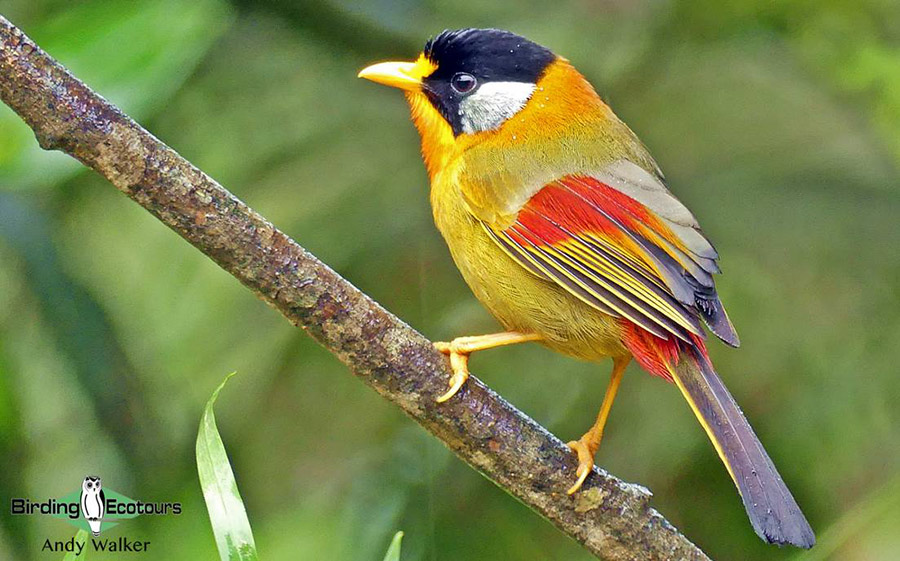
Day 9. Full day birding Doi Pha Hom Pok National Park (Doi Lang)
An exciting day birding along the Thai-Myanmar (Burma) border is on the cards, with some great photographic opportunities too. Literally anything can, and does, turn up here, and we will be primed for Chinese migrants and vagrants, several of them coming to food provided by Thai and Chinese bird photographers.
Some of the possibilities for the day could include Mrs. Hume’s Pheasant, Hodgson’s Frogmouth, Mountain Bamboo Partridge, Siberian Rubythroat, White-bellied Redstart, Burmese Shrike, Black-eared Shrike-babbler, Black-throated Bushtit, Crested Finchbill, Striated Bulbul, Chestnut-headed Tesia, Spot-breasted and Grey-headed Parrotbills, Whiskered Yuhina, Rusty-cheeked Scimitar Babbler, White-browed Laughingthrush, Scarlet-faced Liocichla, Rufous-gorgeted, White-gorgeted, Sapphire, and Ultramarine Flycatchers, Chestnut-bellied Rock Thrush, Oriental Turtle Dove, Mountain Hawk-Eagle, Cook’s Swift, Crested Bunting, and Himalayan Cutia. We have even had the uncommon and tough Rusty-naped Pitta here!
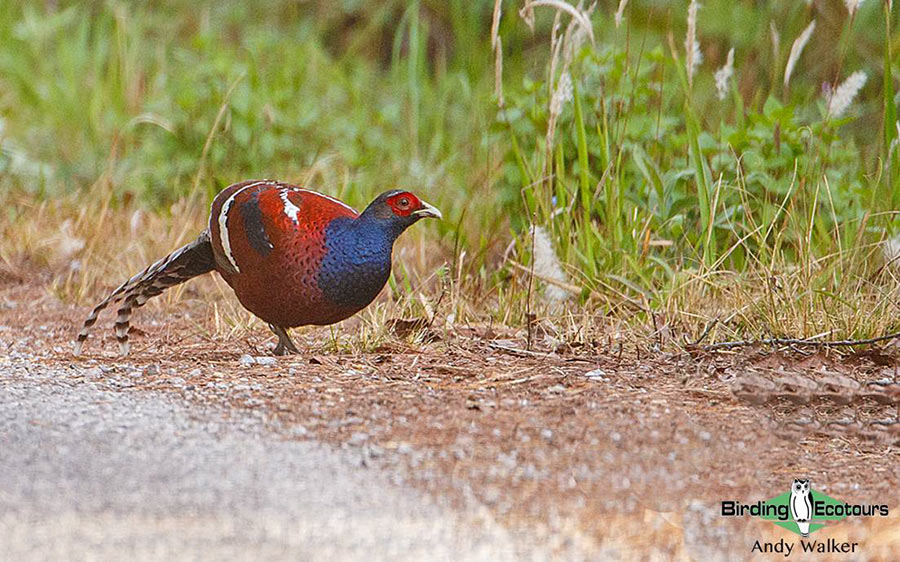
Day 10. Doi Tung – Mae Fah Luang Arboretum, afternoon birding Chiang Saen area
We will leave our base in Fang for the last time and head into the mountains for one final morning session of mountain birding. We will most likely check in on a mountain site that has been very good for migrant thrushes (including several Thai rarities) and other wintering birds over recent years, with species such as Scaly Thrush, Chestnut Thrush, Grey-winged Blackbird, Eyebrowed Thrush, Grey-sided Thrush, Black-breasted Thrush, Dusky Thrush, Naumann’s Thrush, White-tailed Robin, Himalayan Bluetail, Blue-fronted Redstart, and Rusty-naped Pitta all putting in an appearance.
We will arrive at our hotel near Chiang Saen for lunch and in the afternoon we will visit Chiang Saen Lake. We will hope to find an interesting range of wildfowl, and sometimes the lake holds overwintering Baer’s Pochard (if we are very lucky). Other rare wildfowl could include Mandarin Duck, Falcated Duck, or Baikal Teal. Frequently observed species include Ferruginous Duck, Tufted Duck, Common Pochard, Ruddy Shelduck, Garganey, Northern Pintail, Eurasian Wigeon, Eurasian Teal, and Indian Spot-billed Duck. We will also look for Striated Grassbird and Burmese Shrike.
We end the day watching the spectacular harrier roost – made up of hundreds of Pied Harriers and Eastern Marsh Harriers. This really is a sight to behold and a great way to end the tour.
Overnight: Chiang Saen
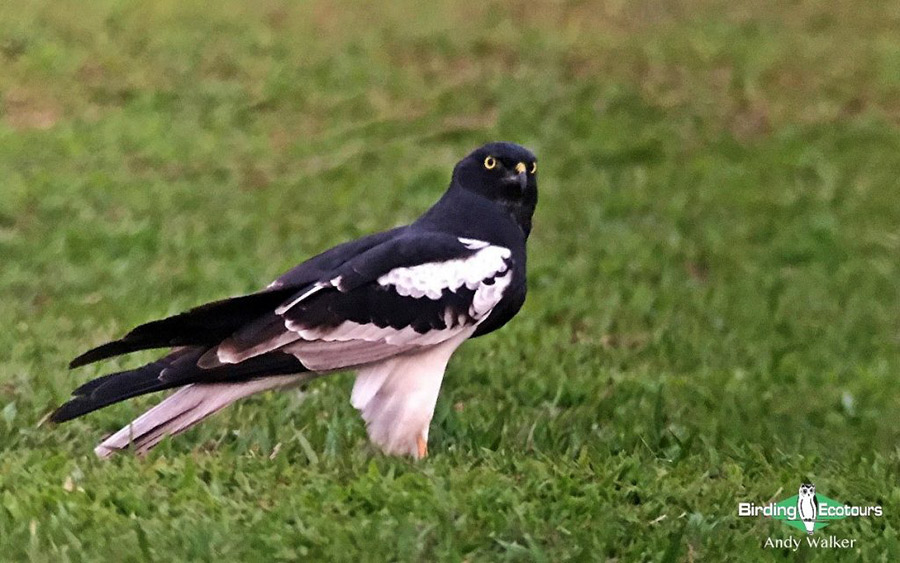
Day 11. Chiang Saen area, transfer to Chiang Mai, where the tour concludes
We will have a final morning birding around the Chiang Saen Lake area before we drive back to Chiang Mai. We will look for wildfowl again, but in doing so we might also find Bronze-winged Jacana, Pheasant-tailed Jacana, Grey-headed Swamphen, Wood Sandpiper, Marsh Sandpiper, Black-winged Stilt, Grey-headed Lapwing, Red-wattled Lapwing, Yellow Bittern, or some interesting migrants such as Baikal Bush Warbler, Dusky Warbler, or Eurasian Wryneck.
Late in the morning we will commence our drive back to the city, arriving in Chiang Mai in the late afternoon, where the tour concludes in time for your evening departure. If you do not wish to depart Chiang Mai this evening we can easily arrange additional accommodation, if required. Please consult us before booking your departure flight from Chiang Mai.
Overnight: Not included
Please note that the itinerary cannot be guaranteed as it is only a rough guide and can be changed (usually slightly) due to factors such as availability of accommodation, updated information on the state of accommodation, roads, or birding sites, the discretion of the guides and other factors. In addition, we sometimes have to use a different international guide from the one advertised due to tour scheduling.
Download ItineraryNORTHERN THAILAND: SPECTACULAR RESIDENT AND MIGRANT BIRDS
TOUR-SPECIFIC INFORMATION
GENERAL INFORMATION ABOUT THAILAND CAN BE READ HERE
TOUR OUTLINE
On this Thai birding tour, we will undertake a short circuit around the mountains (mainly) of northern Thailand as we take in excellent birding sites while we look for an eclectic mix of resident and migrant birds. Some of the areas we will bird include Doi Inthanon National Park, Doi Chiang Dao Wildlife Sanctuary, and Doi Pha Hom Pok National Park (including Doi Ang Khang and Doi Lang). We will also spend some time on the plains of the region which includes the huge Chiang Saen Lake, the mighty Mekong River, as well as expansive rice paddies and lowland scrub. Doi Inthanon is Thailand’s highest peak and has a whole suite of birds found nowhere else in the country and offers some top-quality birding. Some of the many highlights possible on this tour include Mrs. Hume’s Pheasant, Siberian Rubythroat, Pied Harrier, Ultramarine Flycatcher, Giant Nuthatch, Himalayan Cutia, and a long list of thrushes, flycatchers, laughingthrushes, and other spectacular birds. This tour does offer some good photographic opportunities at several of the sites we visit.
DAILY ACTIVITIES, PHYSICAL REQUIREMENTS, AND TOUR PACE
This birding tour runs at a fairly moderate pace but includes only a couple of one-night stays. Time will be spent traversing various mountains in search of a wealth of birds in the different elevation zones. We will bird on forest trails, forest tracks and roads, and will spend time visiting stakeouts and forest blinds/hides for some of the more secretive species.
There will be a fair bit of walking involved and this will often occur at a (relatively, for Thailand) high elevation, with hikes of around 2.5 miles (four kilometers), or more, on most mornings and afternoons. We will of course be walking slowly as we bird. Although in the mountains the majority of trails are flat for sections, but with (usually short) steep sections (these can be in the form of slopes with or without steps). We will also cover similar distances in the rice paddies.
The highest elevation we will be birding at is 8,415 feet (2,565 meters) when we are at the summit of Doi Inthanon. We can drive right to the top of the mountain here so minimal effort is required. We will walk some trails at the summit (there is a boardwalk through the unique, for Thailand, bog habitat here) which we will take at a slow pace. We will be spending a lot of time birding between 3,000–8,000 feet (1,000–2,500 meters) during the days at our mountain birding sites, but we will not be spending nights at elevation, we will drop down to the plains where we will stay at around 1,000–1,600 feet (300–500 meters). See the “Weather/Climate” information below.
It will be necessary to have an early breakfast on most mornings and quite a few of these will be boxed breakfasts taken in picnic-style or as a tailgate breakfast. This will ensure we will be at the birding areas when we need to be. A large majority of lunches will be taken in the field as boxed lunches in picnic-style. We will purchase fresh supplies each day from the nearest large supermarket. It is worth noting that toilet facilities on one of the mountains, Doi Lang, are non-existent, so going to the toilet in the bush will be a necessity at this site, if needed. We are likely to be out of range of a “proper toilet/restroom” for the majority of the day exploring Doi Lang. All the other mountain sites have suitable facilities. This information was accurate based on our 2020 pre-Covid tour (see trip report here), and will be updated as soon as we are allowed back up there!
Despite our accommodation being in the best locations possible, most days will require a drive of up to an hour from our base to where we will be birding. On some occasions we will have to leave the accommodation in the region of 05:00 hrs to get to where we need to be ahead of other birders/photographers, or to just get to the specific mountain pass that we need to be for sunrise. On one morning we will leave our accommodation at 04:30 hrs to reach the birding spot at the start of bird activity, this will require the use of 4×4 pick-up trucks as we drive up a rough mountain road for 90 minutes (more details on this lower down in this section). After the very early starts we will usually take a break back at our accommodation during the early afternoon to take some well-deserved rest. Due to the elevation at some of the sites, the temperature doesn’t get as hot as other areas (see the “weather/climate” section below) so on some days we will be out and away from our accommodation all day, taking a rest over the lunch period (on most mountains this will be in cafes/park buildings, though on Doi Lang this will be within the shade of the forest).
On some evenings we will be birding until after dark. On one evening we will visit a Pied Harrier roost site, we will stay at the site until dark and will then drive back to our hotel, and on another evening, we will be out in the rice paddies until dusk, before driving back to our hotel. On these occasions our evening meals might be later than on other days.
On most days we will have to drive for around an hour to get to the birding spots from our chosen accommodation (which are the best/only choices for places to stay and have been selected based on years of birding in this region of Thailand). There will be a few days where we undertake longer drives, of approximately two to four hours as we move between different overnight bases. Many of the roads we will be taking are winding mountain roads and so if you suffer from motion sickness you will likely need to take some medication to counter the effects. Please note that the majority of sites we visit can be accessed in our regular tour vehicle, however one day trip (to the top of Doi Chiang Dao) will require a 4×4 pick-up truck. Accessing this site is via an approximately 90-minute bumpy road and is possibly not suitable for everyone (e.g. anyone suffering from a bad back), as it is very hard to make this trip particularly comfortable. Anyone not wanting to do this trip is welcome to sit it out and spend the morning birding in and around the grounds of our excellent accommodation (or sleeping in and enjoying a rest and late breakfast!).
Photo identification should be carried at all times, this is a requirement of the local laws but particularly necessary (and likely to get requested) when we are birding near to the Thai-Myanmar border where there are military checkpoints.
The birding in this part of Thailand has a great sense of adventure to it, and our tour offers some really thrilling birds and birding experiences (as well as some simply spectacular landscape views) and the information above should help you to be prepared for what to expect in this remote part of Thailand. If you have any questions on this tour, please message us via our contact form.
Important Note: the majority of mountain birding sites in this region (with the exception of Doi Inthanon), are along the Thai-Myanmar border, and access rules can change without warning, with whole mountains or roads suddenly closed, or other access restrictions put in place. If this happens, we will need to remain flexible and adjust our plans and focus on other suitable areas, of which there are many. It goes without saying that any such situation is beyond our control, but we will do our utmost to make the best out of any unexpected circumstances.
SAFETY
Trips and falls are possible on the trails and mountain roads and care should be taken when walking/getting out of vehicles. A hiking pole or walking stick can be useful for extra support/grip. The weather can be cold and if you are not suitably prepared (see “Weather/Climate” information below) it can be rather uncomfortable and can also lead to illnesses.
WEATHER/CLIMATE
We are likely to experience a wide range of temperatures on this tour. When we are in the lowlands (e.g. in Chiang Mai city, the rice paddies, our accommodations at the foot of the various mountains, and at Chiang Saen) we are likely to get daytime temperatures of 91–93 °F (33–34 °C), but nighttime temperatures may drop as low as 41 °C (5 °C). In the mountains daytime temperatures are likely to be in the range of 50–77 °F (10–25 °C) and nighttime temperatures can drop to 32 °F (0 °C) at Doi Inthanon summit. By the time we reach the summit the temperatures are likely to be just above the nighttime temperatures so will feel cold, and are likely to be around 41 °F (5 °C) when we start birding. Fog and mist are common features in the plains in the early morning period and can persist until the sun burns it off.
The weather (and migrant birds) in this part of Thailand can be heavily influenced by the weather in China and if a cold air mass comes down from the north, temperatures could be lower than those outlined above.
ACCOMMODATION
We will stay in a range of accommodation during the tour, such as in city hotels and nature lodges. All are clean and comfortable with air-conditioning in the room (and/or fans where air-conditioning is unlikely to be necessary) and most have Wi-Fi either in the room or in the communal areas. Our nature lodges at Doi Inthanon and Chiang Dao have good grounds for birding, should you wish to take a break from the mountain birding, and are both situated in excellent birding areas. The city hotels are used for convenience where necessary and we will mainly just be sleeping/eating breakfast/dinner in those as we will be spending full days birding in the mountains, but they are all of a good standard.
MEALS
We will have a range of Thai food during the tour and at a couple of locations we will also have the opportunity for some high-quality western food, should that be of interest to the group, as an alternative. Mealtimes will vary during the tour, depending on the plan for the day. Some meals (several breakfasts and lunches) will be taken as picnics.
WHAT TO BRING: CLOTHING AND OTHER ITEMS
A woolly hat, gloves, and scarf can be useful for our time birding at the summit of Doi Inthanon. Please do not bring army style (camouflage) clothing because we will be birding close to the Thai-Myanmar border where there will be numerous military personnel and checkpoints and this type of clothing might raise suspicion. A hiking pole or walking stick might be beneficial if you are not steady on your feet.
‘We just returned from our trip to Thailand. It was wonderful. Thank you very much for arranging our tour with Andy Walker. He was the best guide we ever had. He is knowledgeable, easy going, hard working, and has all the qualities that people expect from a guide. We really enjoyed birding with him. We would be happy to go birding with him any time and would highly recommend him as a guide to any of our friends.
Thanks again for giving us the opportunity to have him as our guide.’
Ahmad and Sue
‘We spent three weeks with Andy in Thailand and enjoyed the trip thoroughly. Andy worked so hard to find the birds, and get us on them. He was very patient and took the time we needed. He knew all the best places to go, knew what birds would be expected, identified them in an instant and still managed to find some pretty good rarities along with the “known birds”, Himalayan Cutia anyone? And we spent literally hours getting great looks at Spoon-billed Sandpiper. Andy got us very close without disturbing the birds or any other birders. It was a highlight of the trip. We are hoping to see Andy in York later this year for a days birding on his home patch!’
Bob and Terrie

